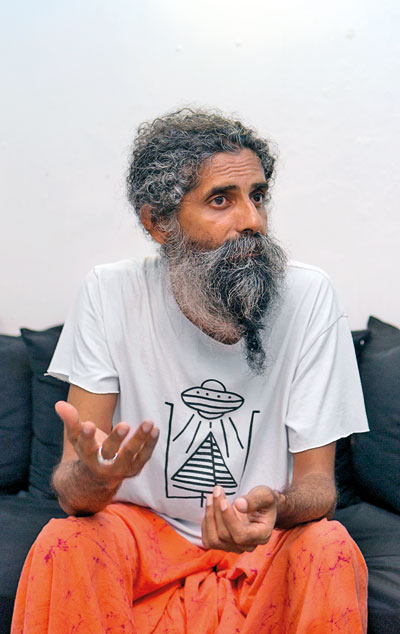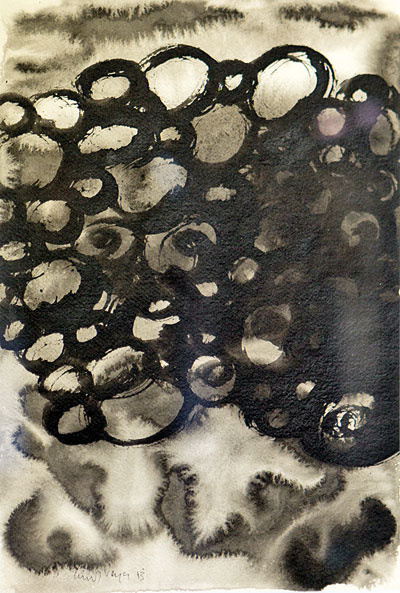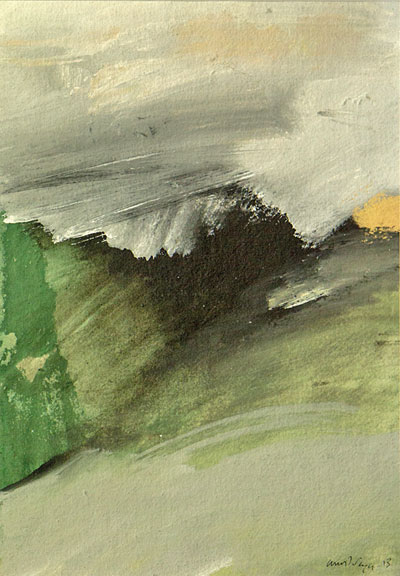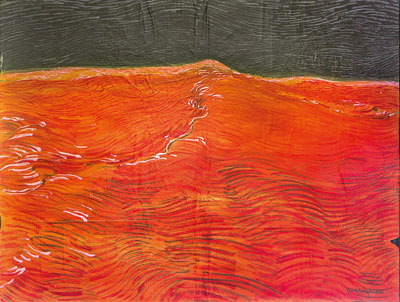Arts
Life is bliss, art is bliss
Anup Vega is so light-footed he seems to tread happily on thin air. He is a vision in Colombo in the afternoon, especially against the timeless charm of the Paradise Road Gallery Cafe. Frail, in a light pink-orange sarong and white T-shirt, he exudes an etherealness, almost a blissful swami in the grinding city where money is the oil and men in suits toil and sweat.

Anup Vega: Living for the moment. Pic by Sameera Weerasekera
Anup ushers us into the Gallery Cafe. Soon the serene, dark, colonnaded verandahs running round the courtyards of the cafe would be hung with the subdued, subtle landscapes and mindscapes that Anup is celebrated for. His latest exhibition, Chanchalatha (Sanskrit for Versatility) began on May 31.
A lot has been written on Anup, most of it casting him as a mystic-eccentric. Now at the threshold of his fifth decade, the artist has many original views, including his personal mutiny against institutional education.
He tells me in his dreamy tones that “as a species we have nothing to learn.” “Look at the animals. They are perfect; they can all swim equally well. Maybe some are weaker, some are stronger- physically. But they are all normal. They all can do what they are supposed to do. No need for education at all. So I don’t believe in education- it is very unnatural.”
His mother, a teacher, ensured he attended school in his village in Kurunegala, but this was such deadly tedium that he frequently chose instead to escape into the outlying wilderness, purging himself of the geometry and history and letting his imagination grow wild to the rhythm of the flora and fauna instead. This communing with nature gave him much inspiration for his later career and work as an artist, in which domain also he resists education and instruction, proud of being self-taught.
To Vega the landscape that undulates around us is of primal importance- whatever we do. That backdrop, with its line in the horizon dissecting sky and land, or sky and sea, is a vital element- influencing what happens within its frame.
Though he drew incessantly in private, Anup’s life as a professional artist began when he got into food sculpting. He worked in a number of luxury hotels- here and abroad- enjoying dealing with butter, ice and other edible material which is work, looking back, he is still nostalgic for. He still gets pleasure from rustling up for himself or family and friends the occasional inspired salad.
It was after the end of studies at Isipathana College, Colombo, that Anup was lured by the teachings of Master Osho the Indian mystic, the founder of the Rajneesh movement. The appeal was instantaneous. “His teachings are very modern and very scientific. It has nothing to do with religion. He is a great poet- just like Jesus and Socrates were.”
It is surely Master Osho’s commandments such as “Love is prayer” and “Do not swim—float”, that gives Anup that enviably light step and attitude- the secret behind the perennial smile and the childlike innocence and love on his countenance.
Anup had no plans for future before or during his culinary art years. He just ‘floated’. But art happened to be something into which he drifted naturally, with karmic habit. During his early years in Colombo, even while at Isipathana, the galleries began to weave their spell on him. At Barefoot and the Hermitage Gallery he walked into a new world. The artists who left the most indelible marks on him were Laki Senanayake and Rahju Michael.
He was lucky to meet them and to be fostered closely by them. These two mentors, with their unique work and their personal ashramic retreats set deep in nature, would spark something momentous within young Vega. Their works infected him with the urge to do something of his own.
Rahju happily worked as the link between Anup and the art circles. The friendships he forged in the Bohemian world of art exposed him to gallery lights and connoisseurs. From that point onwards, there was to be no turning back for Anup.
Today, when not working in his studio, Anup ventures out in his Volkswagen van, or on foot, searching for nature and inspiration. The landscapes of his dreams still wait for him in his favourite regions: Dambulla, the Knuckles range and the dry zone in general. Yet he never judges or analyzes his art. This he maintains is futile and merely tiring. For him there is no reality other than the present moment. All else, including his art and himself, is illusion. “Everything changes and moves – growing, dying, appearing and disappearing. I only experience it- I don’t try to make sense out of it. Life is simply enjoying, simply witnessing.”
Art is part of his celebration of life, just like climbing mountains, swimming in the lakes, “making love, and making music”.
He compares mountaineering to an electrifying ‘trip’. “The elevation makes your nerves feel something. It’s like going to the beach- with the horizon and the vast spaces. When you are above the clouds, everything is different and it all charges you with a different energy.”
Another abiding passion in his life is music. From Indian classical music to Pink Floyd and the contemporary, many kinds of sound and vibration inspire him. In his spare time, he now also enjoys growing vegetables- a peculiar cord binding this gypsy-at-heart to the land to which he was born.
Anup’s exhibition and sale Chanchalatha can be viewed at the Paradise Road Gallery Cafe till June 20.





